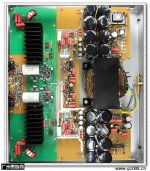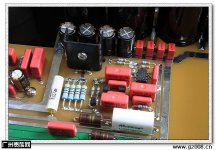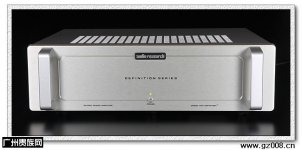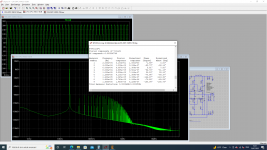yes. It's simple. However, I do not recommend using MOSFET.I understand how to make bridged amps on single supply with no cap outputs. I have designed and built the SuSyLu - a 100w choke loaded SE Class A amp with balanced DC coupled output.
https://www.diyaudio.com/community/attachments/01ad7340-7c7a-4e0c-a763-d20e93961d64-jpeg.987583/
Very simple topology:
View attachment 1071612
It sounds great - perhaps one of the best sounding amps I have heard.
I am just saying, for smaller simple amps, 100w with a SMPS single rail supply can make a great sounding amp. I have lots of great reviews on one of my commercial amps that uses this approach.
@jjasniew, even though my Susyamp is bridged, it still has a nice harmonic profile that is not odd order dominant like PP amps. Here is the FFT:
View attachment 1071608
Because the MOSFET VGS is too high. It is easy to produce crossover distortion.
I recommend using BJT. Or BJT CFP structure. Its distortion is very low. The circuit is very simple.
We can also use tda2050. TDA2030A these cheap chips to make. It costs about $0.20. 25vdc single power mode. Digital amplifier will lose a lot of details in the process of PWM.
Inductors can also cause losses. We used a more complex method, but the performance decreased. I think TJ
Sorry, my English ability is very poor. I don't quite understand what you mean.I have a question. Does BTL in solid state amplifiers cancel even harmonics in the same way as a P-P tube amplifier does? If not, why does that happen in an OPT circuit (tubes driving out of phase) but not in a bridge (two HS / LS pairs driving out of phase)?
But I want to say something. BTL is actually two identical amplifiers. Its performance has not changed.
It's just a work in +. One works in -. But whether + or - their own performance indicators have not changed. Maybe extra long transmission can reduce interference. But there is no difference in practical application.
The distortion of the amplifier mainly depends on the distortion of the circuit structure of the amplifier itself. It is not the difference of BTL.
I compared Jeff Rowland 250. The comparison is my DIY iraudamp7s.Hum, FM Acoustics amps are more and more empty and more and more expensive.
I think the J Rowland has certaintly a better power supply than most can diy here (Pwm)
The little Infineon module is certainly cool but is there any advantage over a circlophon type or a class A ?
I have an old Chord amp... mosfet, 84V rails, pwm PS. Happy with it cause neutral...
Adopt PCB files downloaded by Infineon. And component list.
DIY's iraudamp7s does sound better than Jeff Rowland 250.
Jeff Rowland is an excellent manufacturer. Its model 10 adopts 3886 BTL mode. That's very impressive. But its 250 model uses icepower 250. In fact, this effect is not very good. FM amplifier is an ancient structure. All use npn+npn to work in class ab. It sounds very nice. Although he is not thd most IH
But it sounds very nice. I think DIY is similar to fm115 amplifier. Will bring more harvest.
In fact, many amplifiers in Britain have similar structures. For example, musical fidlity x-a50. NAIM , QUAD。
Both use NPN + NPN structure.
So in my comparison results, I think. Icepower is not a good class D amplifier.
After all, jeffrowland uses the original icepower. But the effect is not good.
If DIY icepower. I don't think it will be good either.
My amp is pure Class A all the time. No crossover distortion.yes. It's simple. However, I do not recommend using MOSFET.
Because the MOSFET VGS is too high. It is easy to produce crossover distortion.
I recommend using BJT. Or BJT CFP structure. Its distortion is very low. The circuit is very simple.
We can also use tda2050. TDA2030A these cheap chips to make. It costs about $0.20. 25vdc single power mode. Digital amplifier will lose a lot of details in the process of PWM.
Inductors can also cause losses. We used a more complex method, but the performance decreased. I think TJ
Even in Class AB, I like the sound of MOSFET amps over BJT. The bass is more muscular in my opinion. The FH9 xrk mod is a favorite amp built by many many people in the Apex thread. It sounds very nice to my ears.
In fact, BJT performance is better than MOSFETMy amp is pure Class A all the time. No crossover distortion.
Even in Class AB, I like the sound of MOSFET amps over BJT. The bass is more muscular in my opinion. The FH9 xrk mod is a favorite amp built by many many people in the Apex thread. It sounds very nice to my ears.
I don't know why many people are interested in MOSFET amplifiers now.
But we need to understand. MOSFET has RDS. When a large current is output. Higher voltage attenuation will occur. The VCE of BJT basically remains unchanged, about 1.2-1.5v. It will not change with the increase of current.
So BJT has a lower VBE. Distortion. Has a better driving force.
Although we can correct the voltage attenuation through negative feedback. But in fact, the driving force of MOSFET is indeed worse。
In addition, I would like to add a statement from a friend above. I don't think class a actually makes any sense. It is a commercial advertising behavior.
We can use simple class-B or class ab.
Use BJT CFP structure. Gain the lowest distortion amplifier in the world.
For example, Halcro in Australia
Add: at present, I have heard that the best class D in the world is dsi200 DS 225 of arc company. I don't know the specific MOSFET model it uses. But it uses irs2092 driver chip. If someone knows what type of MOSFET arc uses, you can tell me.
Attachments
In addition, I want to give you a suggestion. Try to use BJT. Do not use MOSFET.My amp is pure Class A all the time. No crossover distortion.
Even in Class AB, I like the sound of MOSFET amps over BJT. The bass is more muscular in my opinion. The FH9 xrk mod is a favorite amp built by many many people in the Apex thread. It sounds very nice to my ears.
The simplest example is the lme49830 MOSFET standard circuit. And LME49810 BJT standard circuit. Direct comparison. All performance indexes of LME49810 BJT, including distortion and driving force. Better than lme49830. The performance of lm3886 or other chips is also better than that of tda7293。7294.
As a designer. We should not choose a structure because of our preferences.
We should treat problems objectively. 😛
Well it’s a matter of personal preference. TDA7293 sounds better to my ears and the harmonic distortion profile shows why. It is dominant second harmonic vs third harmonic for LM3886. It is objective and subjective - I prefer amps with dominant second harmonic. Like SE Class A etc.
From the TDA7293 Xmas amp, 40w into 10ohms. This chip can go to 100w whereas LM3886 is maxed out around 38w. I gave these amp PCBs out over Xmas of 2020, hence the name Xmas amp.


But we digress as this is thread about the “best” Class D.
From the TDA7293 Xmas amp, 40w into 10ohms. This chip can go to 100w whereas LM3886 is maxed out around 38w. I gave these amp PCBs out over Xmas of 2020, hence the name Xmas amp.
But we digress as this is thread about the “best” Class D.
This should be understood. A MOSFET with 20milliohm Rds on at 40A has less voltage drop than a BJT.MOSFET has RDS. When a large current is output. Higher voltage attenuation will occur. The VCE of BJT basically remains unchanged, about 1.2-1.5v. It will not change with the increase of current.
Jan
This hints at a misunderstanding how feedback works. The feedback will make the output signal less distorting. To work this way, the drive signal to the output devices MUST be more distorting, in order to 'compensate' for the device non-linearity and make the output less distorting.Although we can correct the voltage attenuation through negative feedback. But in fact, the driving force of MOSFET is indeed worse。
Think about it, it is logical.
Jan
Using mosfet for class AB can have low distortion, at least in simulation. Although with BJT the distortion can be lower, but the harmonic profile of the distortion in mosfet is almost monotonic even in high frequency. This is my simulation result of CFA amplifier with vertical mosfet.
Attachments
My amp is pure Class A all the time. No crossover distortion.
Even in Class AB, I like the sound of MOSFET amps over BJT. The bass is more muscular in my opinion. The FH9 xrk mod is a favorite amp built by many many people in the Apex thread. It sounds very nice to my ears.
Any chance you could please provide the link to that thread? I looked long and hard but couldn't find the FH9 xrk mod thread...
BJT VCE basically has no significant change.This should be understood. A MOSFET with 20milliohm Rds on at 40A has less voltage drop than a BJT.
Jan
I mean in practical application. The current we output to the speaker is not very high.
About vce1.2-1.5v.
However, each model of MOSFET RDS varies greatly. Generally used in industrial applications. Very high current MOSFET. RDS is relatively small, but these MOSFET models are generally not suitable for audio analog amplifiers. RDS smaller models. Generally, there is a high CISS coss..
Generally, regular applications such as k1058, j201, or irfp240 9240 RDS are relatively large. About 0.5 euro or more.
MOSFET
In practical application, we can also easily hear the difference with our ears.
BJT analog amplifier has faster dynamic response index. Although its design is more complex.
Because it needs current to drive the triode.
In fact, in hiend brand. 99% of analog amplifiers use BJT. Instead of using MOSFET.
In the same brand. I also compared it. The difference between MOSFET and BJT.
For example, Japanese Accuphase. A100 and P7100. Obviously, P7100 has better driving force.
What do you mean about "dynamic response index"? Slew rate? Using mosfet in output class AB/A can have very high slew rate. Slew rate depend on topology, input current in LTP, compensation, etc. In my simulation on post #70, it have slew rate 331V/uS with PSU 45VDC.BJT analog amplifier has faster dynamic response index.
In fact, many people are studying amplifiers. Including many top manufacturers.What do you mean about "dynamic response index"? Slew rate? Using mosfet in output class AB/A can have very high slew rate. Slew rate depend on topology, input current in LTP, compensation, etc. In my simulation on post #70, it have slew rate 331V/uS with PSU 45VDC.
Their skills are excellent. But the amplifier was not done well.
Because their direction is wrong. SR is actually not very useful. We can refer to British amplifier.
For example, quad405, quad606. Their SR is only 4v/us. Even higher SR will bring bad results. Although this may be criticized. But the reality is true.
For example, the sound quality of ne5532 is much better than that of ad827, and the ad827 SR can reach 300v/us.
But the sound quality of ad827 is very poor. Can you understand what I mean.
What I call dynamic response. When listening to some percussion instruments. It will be more flexible. Faster.
Quad405 606707 it can achieve a higher Sr.
But it uses capacitors. Deliberately reduce SR to 4v/us. yes. They did it on purpose.
Even they emphasized this in the publicity materials. In addition, Naim includes many amplifiers. SR is deliberately designed to be very low. Because it makes the sound smoother. This has nothing to do with the dynamic response at low frequencies. Sorry, my English is poor. I don't know how to describe this
But the low-frequency response of BJT must exceed that of MOSFET. At least it is a MOSFET dedicated to audio. For example, k1058 j201 or similar models. Hexfet is not included.
Last edited:
Sorry, you have so many personal opinions that are at odds with the facts, and no willingness to consider them, that a meaningful discussion is not possible.
Wish you much luck, but I'm out.
Jan
Wish you much luck, but I'm out.
Jan
I do not understand what you mean. How can you measure dynamic response? Or it is about your sound perception and your taste?Can you understand what I mean.
What I call dynamic response. When listening to some percussion instruments. It will be more flexible. Faster.
Very few amplifiers drive the output transistor to saturation due to limitation on the signal voltage from the VAS, so the "on resistance" of MOSFET is never reached. The vto of MOSFETS is typically about 4V, and 6V or more is required to get to 20A, so, unless the VAS can drive 6V beyond the rail then you never saturate the outputs. I think sometimes this is deliberate to avoid rail sticking. This is another reason that VFETS are popular, ie their vto is much lower. To get beyond the rails, you also have to bootstrap the drivers, if there are any. A CFP output with gain can actually get near to rail-rail, but tends to rail sticking. I am one of the very few at DIYA that take any notice of the clipping VPP vs supply voltage. The gain of BJT transistors falls off above a few Amps, making it hard to drive them into saturation.
The fact is that I don't know how to measure this.I do not understand what you mean. How can you measure dynamic response? Or it is about your sound perception and your taste?
I don't even know any data to represent it.
More precisely, I don't want others to believe it. But I know it's very obvious.
Because I have more than 10000 people using the results. Give me feedback on the argument.
And I can easily tell.
But I don't think you need to believe this. Because everyone is only willing to believe what they believe. Not the truth. This sentence comes from (Douglas self) 😛
Many people still insist on using MOSFET Or class D of single power supply. They think this is the best amplifier in the world.
Because they only have this kind of amplifier. There is no comparison. Then this amplifier is the best amplifier in the world.
In addition, although I like to do amplifier measurement.
But in fact, from my experience. These figures do not represent good or bad.
Including thd FFT SQL.
For example, the sound quality of ne5532 is much better than that of ad827, and the ad827 SR can reach 300v/us.
But the sound quality of ad827 is very poor.
Did you account for the substantial noise difference between those two opamps?
In fact, I understand what you think. Because I have been exposed to thousands. Tens of thousands of people. They all have similar ideas.Sorry, you have so many personal opinions that are at odds with the facts, and no willingness to consider them, that a meaningful discussion is not possible.
Wish you much luck, but I'm out.
Jan
I don't want to change their minds. I'm just saying something here. Maybe a few years. Ten Years From Now. You will understand what I mean.
If you all agree with me now. Then I don't have to say that.😛
- Home
- Amplifiers
- Class D
- Performance ranking of CLASS D power amplifier MOSFET.



